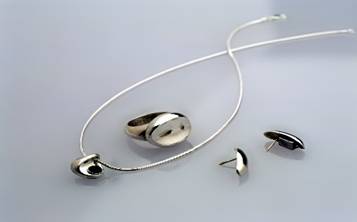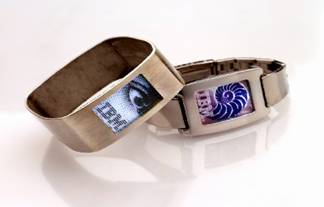





Published on Apr 02, 2024
Digital jewellry is the fashion jewelry with embedded intelligence. "Digital jewellery" can help you solve problems like forgotten passwords and security badges. "Digital jewelry" is a nascent catchphrase for wearable ID devices that contain personal information like passwords, identification, and account information.
They have the potential to be all-in-one replacements for your driver's license, key chain, business cards, credit cards, health insurance card, corporate security badge, and loose cash. They can also solve a common dilemma of today's wired world - the forgotten password.
Soon, cell phones will take a totally new form, appearing to have no form at all. Instead of one single device, cell phones will be broken up into their basic components and packaged as various pieces of digital jewelry. Each piece of jewelry will contain a fraction of the components found in a conventional mobile phone. Together, the digital-jewelry cell phone should work just like a conventional cell phone. The various components that are inside a cell phone :
Microphone, Receiver, Touch pad, Display, Circuit board, Antenna, and Battery .
IBM has developed a prototype of a cell phone that consists of several pieces of digital jewelry that will work together wirelessly, possibly with Blue tooth wireless technology, to perform the functions of the above components.

Cell phones may one day be comprised of digital accessories that
Work together through wireless connections.
Here are the pieces of computerized-jewelry phone and their functions:
• Earrings - Speakers embedded into these earrings will be the phone's receiver.
• Necklace - Users will talk into the necklace's embedded microphone .
• Ring - Perhaps the most interesting piece of the phone, this "magic decoder ring" is equipped with light-emitting diodes (LEDs) that flash to indicate an incoming call. It can also be programmed to flash different colors to identify a particular caller or indicate the importance of a call.
• Bracelet - Equipped with a video graphics array (VGA) display, this wrist display could also be used as a caller identifier that flashes the name and phone number of the caller.
With a jewelry phone, the keypad and dialing function could be integrated into the bracelet, or else dumped altogether -- it's likely that voice-recognition software will be used to make calls, a capability that is already commonplace in many of today's cell phones. Simply say the name of the person you want to call and the phone will dial that person. IBM is also working on a miniature rechargeable battery to power these components

The same ring that flashes for phone calls could also inform you that e-mail is piling up in your inbox. This flashing alert could also indicate the urgency of the e-mail.
The mouse-ring that IBM is developing will use the company's Track Point technology to wirelessly move the cursor on a computer-monitor display. (Track Point is the little button embedded in the keyboard of some laptops). IBM Researchers have transferred TrackPoint technology to a ring, which looks something like a black-pearl ring. On top of the ring is a little black ball that users will swivel to move the cursor, in the same way that the TrackPoint button on a laptop is used.
This Track Point ring will be very valuable when monitors shrink to the size of watch face. In the coming age of ubiquitous computing, displays will no longer be tied to desktops or wall screens. Instead, you'll wear the display like a pair of sunglasses or a bracelet. Researchers are overcoming several obstacles facing these new wearable displays, the most important of which is the readability of information displayed on these tiny devices.

FIGURE 4
Charmed Technology is already marketing its digital jewelry, including a futuristic-looking eyepiece display. The eyepiece is the display component of the company's Charmed Communicator, a wearable, wireless, broadband-Internet device that can be controlled by voice, pen or handheld keypad. The Communicator can be used as an MP3 player, video player and cell phone. The Communicator runs on the company's Linux-based Nanix operating system.
Digital jewelry devices consist of a screen or display for information, most likely consisting of 7-16-segment, or dot matrix LEDs, LCDs, or other technologies such as electroluminescent material (EL) or others, which could become an optional display. So too, an audiovisual or other 'display' could consist of a speaker, a single flashing light, a sensor of some kind (such as a temperature driven EL display), or other informational aesthetic. The display layer sits on a face of the device, which is enclosed in some material such as plastic, metal, crystal, or other material. It has external switches and buttons on its side and a data-port for accessing the programmable electronic circuit inside. A micro controller that is a surface mounted device (SMD) on a printed circuit board (PCB) with resistors (R) and capacitors (C) are the internal 'guts' of the jewelry.
The digital jewelry display, for instance, every alphabet and number system has found representation within the electronics realm and 'dot-matrix' (a matrix of single LEDs) is used to display Chinese and Japanese and other character sets, as can the alternative display for LCDs (liquid-crystal-displays) also be used, as often found in watches.
Digital Jewelry can be made in many different sizes and shapes with a variety of materials ranging from plastic and metal to rubber and glass. They utilize electromagnetic properties and electronics to display information through a screen or display of some kind. This could range from LED 7-segment, 16-segment, dot matrix, and other programmable LEDs devices to LCDs, OLEDs, and other displays, which are all driven by the self-contained jewelry devices themselves.
The closest comparison to this model is that of 'beads' which are strung together to make a custom necklace or bracelet, with interchangeable electromagnetic component systems or devices. One bead may be a capacitor on the inside, and a solar panel on the outside. Another bead may have an internal resistor which feed power into a programmed microcontroller bead which drives an external screen, with other options available in a variety of bead configurations which compose a circuit, including beads with a piezo element, voltage regulator, crystal, or rechargeable battery as part of the modular jewel circuit. The number of data pins on the microcontroller needs to be enough to easily program the display layer plus the switches without overly complex and advanced coding methods

The basic idea behind the digital jewelry concept is to have the convenience of wireless, wearable computers while remaining fashionably sound. It is hoped to be marketable soon, however, several bugs remain. Charging capabilities and cost are just a sample of the problems that lurk
| Are you interested in this topic.Then mail to us immediately to get the full report.
email :- contactv2@gmail.com |